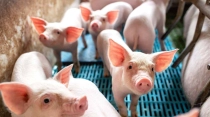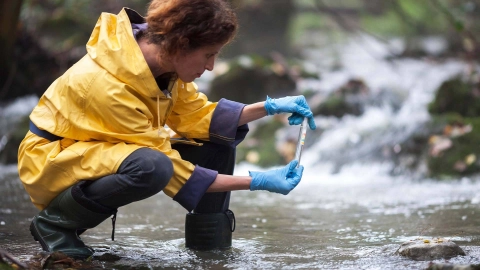Healthy living Zoonotic diseases: when humans and animals infect each other
Many human infectious diseases have their origin in the animal kingdom and can make both humans and animals sick. Examples are rabies and Lyme disease (borreliosis). In this article, you will learn about other zoonotic diseases, how they can be transmitted and how you can protect yourself.
At a glance
- A large portion of infectious diseases in humans are zoonotic diseases.
- Zoonotic diseases can be transmitted from animal to human, human to animal or in both directions.
- Emerging zoonotic diseases like COVID-19 can cause epidemics and pandemics.
- Well-known zoonotic pathogens like salmonella are widespread in livestock and pets and can be repeatedly transmitted from these animals to humans.
- A transmission may occur via direct contact with animals, animal foods and vectors such as ticks.

What is a zoonotic disease?
Infectious diseases that occur in humans and animals – vertebrates, to be precise – and can be transmitted between them are called zoonotic diseases. They constitute a majority of known infectious diseases in humans. Zoonotic pathogens may be viruses, bacteria, parasites and fungi. But disease-causing proteins – known as prions – can be transmitted between animals and humans and cause diseases. Humans can be infected with zoonotic pathogens through direct contact with animals, contaminated food or live vectors such as ticks and midges.
How common are zoonotic diseases?
More than 200 different zoonotic diseases are currently known. They constitute a large percentage of infectious diseases in humans. A good two-thirds of emerging infectious diseases have an animal origin. Even though there were already epidemics caused by zoonotic pathogens previously, such as the Spanish flu, outbreaks of new zoonotic infectious diseases have increased in recent years. Some examples are the lung disease SARS (2002), the swine flu H1N1 (2009), the lung disease MERS (2012), Ebola hemorrhagic fever (2014) and COVID-19 (2019).
What types of zoonotic pathogens are there?
Zoonotic pathogens can be bacteria, viruses, parasites and, more rarely, also fungi or proteins that are harmful to health – known as prions.
Bacteria
Bacteria are single-cell microorganisms with various forms, sizes and properties. At any time, humans and animals have a multitude of colonies of harmless and even beneficial bacteria. But certain bacteria can also cause illness. Examples of disease-causing bacteria that can be transmitted from animals to humans or vice-versa are:
- Lyme disease (borreliosis)
- Campylobacter (campylobacter infection)
- Salmonella (salmonellosis)
- Staphylococci
viruses
Viruses are tiny structures without their own metabolism. In order to be able to multiply, they need a host. Viruses are therefore not considered to be living things. Unlike bacteria, viruses are never beneficial for animals or humans. But they are not always harmful either. Examples of zoonotic viruses are:
- TBE virus (tick-borne encephalitis)
- Hantavirus (hantavirus disease)
- Rabies virus (rabies)
- Dengue virus (dengue fever)
- Ebola virus (Ebola hemorrhagic fever)
Parasites
Parasites are single or multicellular organisms such as worms that use a host – an animal, human or even plants – as their food supply. Sometimes they can also transmit pathogens. There are no advantages for the host. Examples of zoonotic parasites are:
- Toxoplasma (toxoplasmosis)
- Plasmodia (malaria)
- Tapeworms
- Ticks
- Fleas
Fungi
Fungi are multicellular organisms that colonize humans and animals and can make them sick. An example of a zoonotic fungus is Microsporum canis, which commonly infects dogs, cats, horses and rabbits, and can also trigger a skin disease (dermatophytosis) in humans.
Prions
Prions are misfolded infectious proteins that can be ingested with animal foods. If prions get into the brain, they cause decomposition of the brain tissue. Through products from cattle that have bovine spongiform encephalopathy (BSE), prions can be transmitted to humans and cause a deadly disease called “Variant Creutzfeldt-Jakob Disease”. This is also a zoonotic disease.
How are zoonotic pathogens transmitted?
Some zoonotic diseases are predominantly transmitted from vertebrates to humans (zooanthroponosis), others primarily from humans to vertebrates (anthropozoonosis). For some zoonotic diseases, the transmission is in both directions. What is more, it may be that both vector and recipient – in other words, animal and human – become sick and show symptoms. But in that case, the symptoms may be quite different. It is also possible for only one of either infected human or animal to show symptoms and the other to be entirely symptom-free, but sometimes shed pathogens.
People can be infected with zoonotic diseases in various ways by wild animals, domestic animals and pets:
Direct contact
Pathogens can be transmitted via direct contact between animals and humans. In particular, pathogens can be transmitted by close contact with pets – for instance due to cuddling, licking or scratches. For example, cats may transmit toxoplasma, which can be especially dangerous for pregnant women and the unborn child. Animals without fur may also be vectors. Amphibians and reptiles can thus infect humans with various types of salmonella – this usually occurs during handling or contact with the animals’ droppings. For many pathogens, the risk of being infected by pets and getting seriously ill is rather low for healthy people. However, it is sensible to be vigilant about good hygiene when handling the animals – especially for children, pregnant women or people with a weakened immune system. With other zoonotic pathogens however, a preventive vaccination can provide safe protection. Dogs and cats should thus always be vaccinated against rabies. Pet owners can also prevent infections with parasites such as tapeworms with regular deworming.
Unlike pet owners, people who have close contact with wild animals – for instance because they hunt them or they live nearby due to the loss of habitats – are at higher risk of being infected with potentially dangerous zoonotic pathogens. The reason is that in some wild animal populations, there are many pathogens that are still unknown. Bats and flying foxes in particular are considered significant sources of new zoonotic diseases. Rabies, Ebola and MERS for example, along with probably SARS and SARS-CoV-2, have their origin in these animals.
People involved in farm animal husbandry also have an increased risk of infection. An additional risk is that animals from conventional livestock farming often carry multi-resistant pathogens (MRP) that can be transmitted to humans. These are bacteria that are insensitive to several antibiotic active ingredients. In particular, they include methicillin-resistant Staphylococcus aureus (MRSA) and extended spectrum beta-lactamase (EBSL)-producing enterobacteria. Among other things, these bacteria may cause wound infections and endocarditis. Infections with multi-resistant bacteria are very difficult to treat if established antibiotics do not work.
Animal foods
Bacteria from livestock farming can be transmitted to consumers via raw animal foodstuffs such as milk, eggs and meat. What is more, an infection with bacteria like salmonella or campylobacter via contaminated food is quite common. The reason for this is often inadequate kitchen hygiene when handling raw animal products. For healthy people, that is usually harmless, but for people with a weakened immune system, parents of small children or pregnant women, care should be taken when handling eggs, raw milk and raw fish and meat to ensure adequate hygiene during preparation. These products should moreover not be consumed raw.
Video How can foodborne infections be prevented?
The following video explains what can be done to prevent foodborne infections.
This and other videos can also be found on YouTube
Watch nowThe privacy policy indicated there applies.
What is the One Health approach and what does it have to do with zoonotic diseases?
Many scientists assume that the risk of pandemics is rising due to increasing zoonotic diseases. Human influences in particular are seen as a cause of additional zoonotic diseases. The natural habitats of wild animals are being destroyed by climate change, the spread of cities and large-scale clearing of forests. Many wild animals therefore have to divert into areas where humans also live. This can result in increased contact between humans and wild animals. Furthermore, climate change can encourage the spread of midges and ticks, which may transmit pathogens. People moreover come into contact with the pathogens of wild animals more often through the hunting and sale of them. Last but not least, intensive livestock farming contributes to pathogens – some multi-resistant – being transmitted from animals to humans and vice-versa.
This shows that the health of humans, animals and the environment are closely associated. There can thus be only one health for all: what is required for the health of people is thus also required for the health of animals and the environment. This concept is termed “One Health”. The One Health approach reveals and acknowledges how important responsible behavior in human and veterinary medicine as well as in environmental science is for the well-being and health of all involved.
What can be done against zoonotic diseases?
To limit the spread of zoonotic diseases and thus the spread of new infectious diseases, comprehensive measures from governments and the World Health Organization (WHO) are necessary in the interests of the One Health concept, such as the construction and development of early warning systems. Intensive research is also needed to better understand zoonotic diseases and thus successfully prevent or fight them. In Germany, the Nationale Forschungsplattform für Zoonosen (National Research Platform for Zoonoses) has been dedicated to this task since 2006.
In addition, everyone can do something for themselves to avoid getting infected with zoonotic pathogens:
Cooking and eating
- When handling raw animal products, ensure adequate kitchen hygiene.
- Ensure meat is well cooked through.
- Reduce meat consumption.
- Buy regional products when possible.
Handling animals
- Avoid contact with wild animals.
- After contact with animals or excrement, wash hands thoroughly, especially before eating.
- Immediately rinse bite or scratch wounds with water.
- Regularly have pets undergo a veterinary examination, including regular vaccinations and deworming.
Preventive health through vaccinations
You can get vaccinated against some zoonotic pathogens to reduce the infection risk, for instance against influenza viruses and SARS-CoV-2. However, some vaccinations are only recommended when there is an increased risk of infection, such as traveling to a risk area. Examples of this are vaccinations against tick-borne encephalitis, yellow fever and rabies.
Protection from midges and ticks
Because midges and ticks can transmit a wide variety of zoonotic pathogens, it is sensible to protect yourself from midge and tick bites. Among other things, anti-insect sprays and long clothing help with this.
Read more about protection from midges and ticks in our article about exotic infectious diseases.
Where should people go for more information?
The National Research Platform for Zoonoses offers information about zoonotic diseases, profiles of select zoonotic diseases and their key research areas on its website zoonosen.net.
- Arbeitsgemeinschaft der Wissenschaftlichen Medizinischen Fachgesellschaften e.V. (AWMF). Tinea capitis. S1-Leitlinie. AWMF-Registernummer 013-033. 01.2019.
- Deutscher Bundestag, wissenschaftliche Dienste. Zoonosen: Begriffsdefinitionen, historischer Überblick, Pandemiepotenzial. 01.2021.
- Irving, AT, Ahn M, Goh G et al. Lessons from the host defences of bats, a unique viral reservoir. Nature 2021. 589: 363-370. doi: 10.1038/s41586-020-03128-0.
- Köck R, Cuny C. Multiresistente Erreger bei Tier und Mensch. Medizinische Klinik – Intensivmedizin und Notfallmedizin 2020. 115: 189-197. doi: 10.1007/s00063-018-0487-x.
- Niedersächsisches Landesamt für Verbraucherschutz und Lebensmittelsicherheit (Laves). Zoonosen. Aufgerufen am 16.08.2021.
- Nationale Forschungsplattform für Zoonosen (zoonosen.net). Was sind Zoonosen? Aufgerufen am 17.08.2021.
- Nationale Forschungsplattform für Zoonosen (zoonosen.net). Zukunftsthema Global Health: Epidemien erfordern globale Lösungen. 10.2018.
- Robert-Koch-Institut (RKI). Empfehlungen der Ständigen Impfkommission beim Robert Koch-Institut 2020/2021. Epidemiologisches Bulletin. 34/2020.
- Robert-Koch-Institut (RKI). Livestock-assoziierte Methicillin-resistente Staphylococcus aureus (LA-MRSA) als interdisziplinäre Herausforderung. Aufgerufen am 19.08.2021.
- Schuster N. Zoonosen durch Haustiere: Freunde mit Risiken. Pharmazeutische Zeitung. Aufgerufen am 05.01.2022.
- World Health Organization (WHO). Zoonoses. Aufgerufen am 16.08.2021.
As at:






